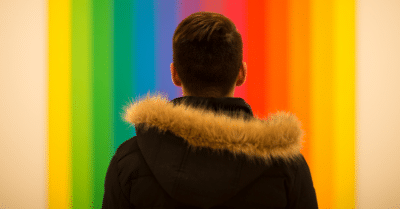What Does the Color of Your Aura Mean

Learning how to see aura colors is an indication of the sort of energy that is radiated from a person, being, or object. Aura colors can indicate everything from core personality traits to passions, moods, and a person's true purpose.
However, even if you have a grasp of auras colors, you may still have lots of unanswered questions about them.
Can anyone learn to read auras, or it an innate skill? Is it possible to see your own aura, or does someone else have to read it for you? Does a person's aura ever change over time, or does each person have a particular color of aura for life?
In this article, we'll explain all the basic information you need to know in order to start reading auras. We'll take you through the key steps, and we'll explore the meaning of the 11 most common colors of auras.
What Is An Aura And What is Aura Energy?

As noted at the outset, our aura colors are related to the energy we radiate. If you can see them, they look like e a kind of luminous light that surrounds the body.
Sometimes, there may be more than one layer, and each may be differently colored.
While precise interpretations of the nature of auras will vary between different spiritual traditions, there is broad agreement that they reflect something important about your state of being.
One widely endorsed explanation is that they relate to the low levels of electromagnetic energy that the human body produces. All living things have this – not just humans, but animals and plants.
If you're already familiar with the Law of Attraction literature, you might find it helpful to think of aura energy as similar to your vibrational frequency.
They're influenced by everything about you, and can, in fact, fluctuate depending on your well-being and experiences.
5 Steps: How to Read Auras for Beginners
Now that you know what aura colors are and what they might mean about a person, let's go through the steps you need to take in order to see auras for yourself.
Learning how to see your aura colors is slightly different from detecting the auras of other people, but both require the same basic preparatory steps.
It takes time, effort, and cares to develop these skills to their fullest extent, but even on your first few attempts, you should be able to detect at least the vague sign of an aura.
Step 1: Be Aware Of Surrounding Energy

Whether you're trying to detect and interpret your own aura or sensing an aura in someone else, it's important to get into the right frame of mind, to begin with.
If you're focusing on your own aura, some experts advise rubbing your hands together to spike your energy.
As you separate your palms and let them face each other, you might feel gentled tingling or a sense of magnetism.
The energy that you detect here is the same energy that you're looking for when you read an aura.
Sensing auras is also easier after a session of meditation or mindfulness exercises. If you don't have time to do a proper session, you may find that even just spending a few minutes closing your eyes and breathing slowly and deeply can help to clear your mind and make you more receptive to the nuanced energy in the world.
In general, anything that calms your thoughts and makes you feel centered will also make you better at detecting energy and reading auras.
Step 2: Adjust Your Peripheral Vision

Whether you're looking at yourself or others, seeing visual auras require slightly adjusting the ways you look at the world.
More specifically, adjusting your peripheral vision is key. You need to work on slightly softening your vision as you narrow your eyes, almost as if you're squinting.
While you should still be able to see clearly, everything should be just a little out of focus.
If you look at candles or overhead lights and can see their light almost "smudging" or spreading wider than usual, you've adjusted your vision in the right way.
It's often slightly easier to do in brighter rooms or in natural light, but as you get increasingly skilled at reading auras you will find that you can pick them up even in dull conditions.
Step 3: See The Different Aura Colors Appear

Once you've adjusted your vision, you should be able to see the relevant aura.
One of the first things you'll notice is that it has multiple layers. You should be able to see seven in most cases, and these are sometimes called 'auric bodies'.
In theory, they correspond to the 7 chakras, so each one gives you a different set of insights.
The physical level (closest to the body) indicates your physical wellness and health, while the etheric level (the next closest to the body) relates to self-image.
Next, the vital level indicates your intellectual well-being and your current thinking, while the Astra level provides information about relationships.
The lower and higher mental levels come after the astral level and related to your true purpose and your spiritual state. Finally, the intuitive level provides clues to your connection with the wider universe.
Step 4: Start Reading Auras Of Your Friends

When reading auras, it's most helpful to get your friends to stand with a white (or pale) wall behind them. This provides a useful point of contrast against which to compare their aura. Reading areas is also more information if your friend is in a highly receptive, clear-minded state.
This means it's often a good idea to meditate or breathe together beforehand so that you're both focused and entirely present in the moment.
If this person is on a self-development journey, it makes sense to read their aura regularly and make notes that allow you to compare the different readings over time.
With the help of our aura interpretation guide (below), you and your friend can make more sense of how their wants and needs are shifting as they work towards their goal.
Step 5: Practice Reading Your Own Aura Colors

If you're wondering how to see your own aura in the mirror, many of the above tips (for reading the auras of friends) apply here.
In particular, it's good to stand with your back against a white backdrop and to ensure that you're in a calm frame of mind before the reading.
Note that some people try to detect the aura that encompasses their whole body, while others focus on one body part – usually the hands.
To use your hand when reading your own aura, simply hold it out as far as possible and adjust your vision to make it soft and hazy.
You should be able to detect a fine kind of mist around your hand, often with multiple layers that correspond to each of the chakras.
What Are The Different Aura Colors And What Are Their Meanings?
So, you know how to see aura colors and have a basic grasp of how to begin reading your own aura as well as those of your friends.
But what do the different aura colors mean, and how do you piece together the meanings of the different layers?
These 11 aura colors are some of the most common, though we've also included some rare aura colors that can be especially significant.
Aura work is always intuitive and open to subjective interpretation, but these colors are reliable indicators that certain feelings, needs, and thoughts are prominent for the person at the time the aura appears.
Yellow Aura

If any layer of your aura is yellow, this means that you're playful or curious.
Sometimes, this indicates entering a new phase of your life and reexamining things you used to take for granted, and at other times it might mean you're reconnecting with the fun, childlike part of yourself.
Yellow aura meanings also indicate relaxation and positivity. All things considered, yellow is a sign that you're doing well and feeling good.
The rare exception to this is bright, neon yellow that is sometimes connected to fear (especially fear of losing control).
Green Aura

Green aura meaning varies depending on the shade. For example, a muddy green shade can be linked with jealousy.
However, the most commonly seen shade is a bright mid-green that is associated with healing.
Depending on where the green is, this healing can be at the level of your physical or mental life. Green also has a broad relationship with growth and forward momentum.
Taken together, these two meanings suggest that green aura colors often show up when you're processing the wounds from a difficult time and deliberately moving forward onto something better.
Purple Aura

What does a purple aura mean? In most cases, it highlights spiritual openness and awareness.
So, it's a common color to see as part of your aura after attending a spiritual event, meditating, or working on visualizations.
Purple aura meaning guides also often mention sensitivity as well, so you may be more open to other people and their feelings than you exhibit purple in your aura.
If you see purple in your aura, this suggests a time of high receptivity, when you're defenses are low and your thinking is flexible.
Blue Aura

Blue auras can vary in shade, but a bright, clear blue is associated with intuition.
In terms of meaning, blue auras often show up when you are developing confidence in your gut feelings and are prioritizing your heart over your head.
Blue auras are also often seen in calm, balanced people who are at peace with themselves.
In contrast, a darker blue may suggest fear of being honest or of hearing something difficult.
If you see dark blue, you may know that you're poised to experience a major change but haven't accepted it.
White Aura

People often simply assume that a white aura suggests innocence of some kind, but white aura meanings are actually more nuanced than this.
So, what does a white aura mean? They are incredibly rare, and you're only likely to see them when a person has become their fully evolved self.
There is a link to purity, but that purity is more about spiritual purity than psychological innocence.
If you see white in your own aura, this is a sign that you're reaching full, true enlightenment. As such, as it's more commonly seen later in a person's life.
Orange Aura

Any orange aura meaning guide will mention the connection between orange layers and personal power.
Once again depending on the layer, orange in your aura can mean physical strength and peak health, or it can mean self-confidence and mental power.
Orange also suggests creativity, so you'll often find it in the auras of artists, writers, and musicians.
When the orange tends towards a more brown shade, you'll sometimes see it in people struggling with these addictions.
These may not be associated with substance abuse – any repetitive, compulsive negative behavior can lead to this darker orange shade.
Red Aura

In general, red is tied to power and action. The brighter and purer the red, the more self-sufficient and decisive the person is likely to be.
For example, if you've recently decided to buy a house or change careers, it wouldn't be surprising to see red.
That said, you may see darker shades of red in times of repressed anger.
You'll also see dark red when you're feeling very resentful but haven't shared this with the person who hurt you.
Meanwhile, if you see a cloudy read, you might be picking up on underlying anxiety about something.
Pink Aura

Pink aura meaning depends on the shade, as with all colors.
You'll often see warmer pinks described as being colors of the heart, so they're frequently present when you're in love.
This doesn't need to be romantic love.
Pink auras are also regularly seen in brand new parents, for example.
A deeper pink can be a sign that you've balanced your physical, mental, and self-care needs well.
Black Aura

Like white auras, black auras are fairly rare.
If you see a pure black aura, you're picking up on serious negativity and a sense of stuckness in them.
It is common for you to have a black aura if you won't forgive someone and are holding onto resentment.
Grief is another frequent (and unavoidable) cause of black auras, though in this case, you'll see regular and rapid changes as you go through the intensely emotional process of loss.
Brown Aura

The meaning of brown auras tends to be fear-based.
Sometimes, this is related to a superficial fear, such as a scary experience you had earlier in the day.
In other cases, there's a deeper meaning here, such as a fear of the unknown or fear of commitment.
Any time you spot a brown aura, there's an invitation to think honestly and carefully about what you might be avoiding, and why you're avoiding it.
Often, once you begin to think concretely about the thing that scares you, it will become much more manageable.
Grey Aura

Finally, grey auras tend to indicate a block.
Grey aura meanings include self-imposed stagnancy (not leaving your comfort zone) and boredom or restlessness that is beyond your control.
Look carefully, however – if you're seeing a bright, shimmery grey that is silver, this is often abundance.
You may see it when you've recently come into money, or when you're enjoying large material gains of some sort.
In rarer cares, silver is also connected to mental abundance – to feeling supported, known, and understood by others.
How To Attract More Effectively With The Law Of Attraction By Improving Your Aura Energy
Once you've grasped aura readings and meanings, there are many benefits to combining this knowledge with the Law of Attraction. Firstly, reading your own aura can tell you a lot about your current vibrational frequency.
Whether you're vibrating on a frequency of abundance or lack.
In the former case, you get a cue that tells you to keep doing what you're doing.
In the latter case, you get information that tells you that you need to do something different.
Meanwhile, if you work to make your aura more positive, you'll improve your ability to manifest the things you desire.
Visualizing yourself surrounded by bright yellow, bright red, and green can help you to shift your aura's frequency.
Then, using regular aura checks, you can log and track whether your use of Law of Attraction techniques is helping you make the vibrational shifts you need.

What Does the Color of Your Aura Mean
Source: https://www.thelawofattraction.com/aura-colors/